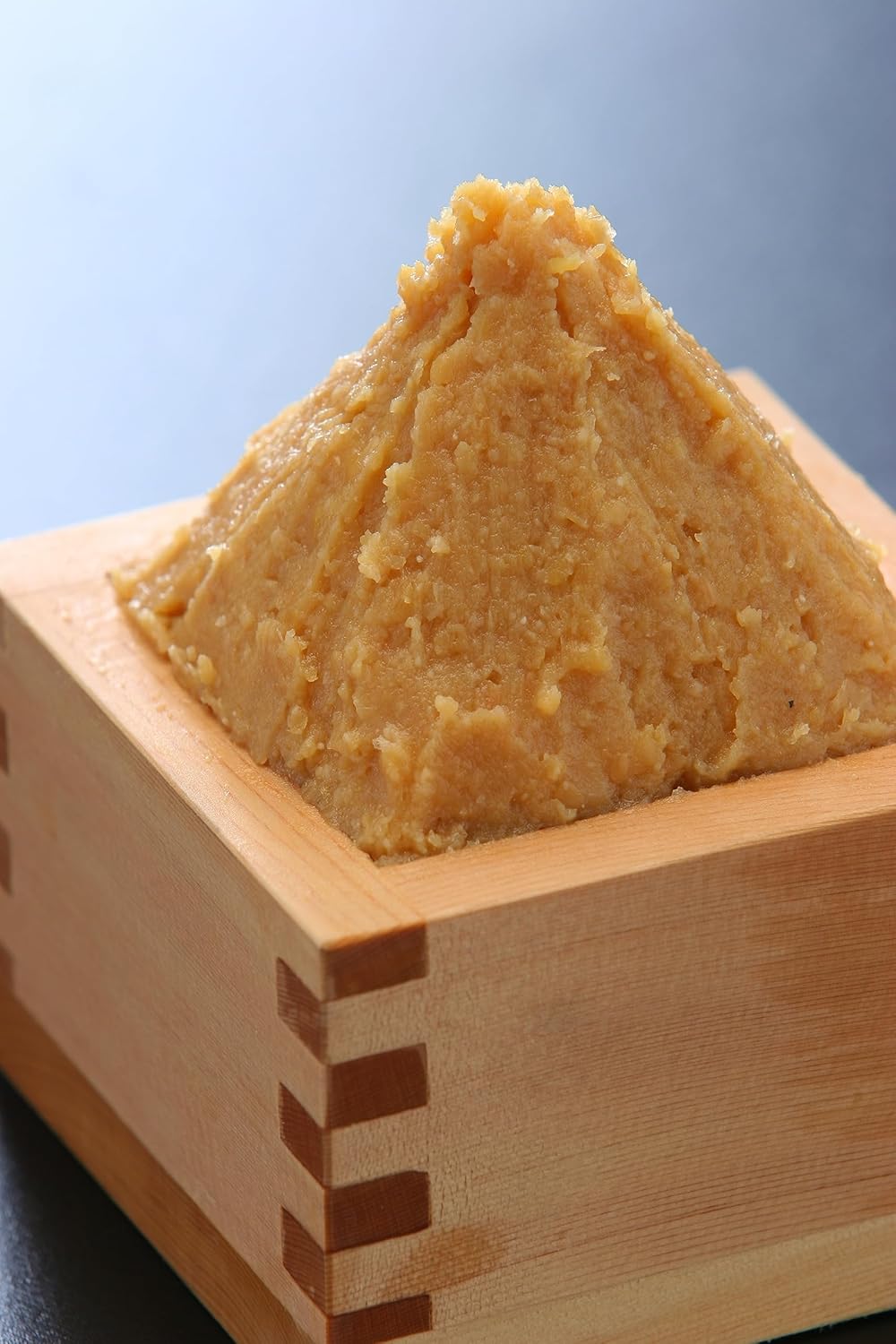Hulu’s hit series The Bear revived our collective interest in the culinary arts. From its dramatic storylines to its fast-paced cooking and beautiful plating, it’s hard to pinpoint exactly why this show is so captivating. But if we were to guess, we’d say it has a lot to do with the chemistry between chefs Carmen “Carmy” Berzatto (Jeremy Allen White) and Sydney Adamu (Ayo Edebiri).
 Ayo Edebiri/Instagram
Ayo Edebiri/Instagram
Off-screen, Edebiri has been showing off her cooking skills (some of which she learned for the show) while showcasing some flavorful ingredients, including miso—an umami-rich paste used widely in Japan. On a recent episode of Vogue’s cooking series “Now Serving”, Edebiri prepared a pasta dish with a miso butter sauce and furikake bread crumbs.
But what is miso exactly and how do you cook with it? Let’s hear a collective “yes, chef” before learning to use miso like Edebiri does.
What is miso?
Though miso has become a staple of Japanese cuisine, it is believed to have originated in China or Korea. According to the Japan Miso Promotion Board, miso was first introduced in Japan in the 7th century.
Initially, it was a delicacy available only to Japanese nobility and monks. By the 12th century, miso soup had become a dietary staple for Kamakura samurai. Over time, farmers began making their own miso, leading to regional varieties across Japan. Today, miso has made its way into dishes around the world.

“If you’re a sushi-goer, you’re likely to start your meal with miso soup studded with soft tofu bits, onion, and seaweed, but the truth is, it’s an amazing powerhouse of a superfood that has been enjoyed for over a thousand years in traditional Japanese preparations and has been reimagined as a culinary secret weapon in all types of cuisine,” Mareya Ibrahim, chef and host of Facebook Live show The Real Dish, tells VegNews.
“Since it’s fermented, it’s wonderful for gut health and is packed with antioxidants and probiotics, which are fantastic for digestion and improving immune functions,” Ibrahim says. “And there’s so many ways to incorporate it into your dishes beyond soup.”
An essential in many Japanese dishes, miso is a fermented paste made from soybeans, salt, grains, and Aspergillus oryzae (or koji), a type of mold spore. The type of grain used to inoculate the koji is one key distinguisher between types of miso.
The fermentation process, which can last for a few months and up to several years, breaks down the soybeans’ proteins into amino acids, creating miso’s unctuous flavor. “Miso is naturally rich in glutamates, which are natural compounds that create the savory taste known as umami,” Jennifer Pallian, a Registered Dietitian and food scientist, says.
“Glutamates enhance the depth and richness of the flavor in the food, making miso a nearly magical ingredient for lovers of savory flavors,” Pallian says.
Types of miso
There are numerous types of miso, each differing in texture, flavor, and color, depending on the fermentation time and ingredients used. Below are the most common varieties used.
 Getty
Getty
BECOME A VEGNEWS VIP: Get exclusive product deals, freebies, and perks galore!
Shiro (White) Miso: Sweet and mild miso made with a high proportion of rice koji to soybeans and fermented for a shorter period (three months to a year). It is ideal for lighter dishes, such as salad dressings, marinades, and delicate soups.
Shinshu (Yellow) Miso: Often fermented slightly longer than shiro miso, this golden yellow miso has a mild flavor, suitable for a range of dishes.
Aka (Red) Miso: A darker, richer miso made with more soybeans than rice koji and fermented for a longer time (up to several years). Its robust flavor pairs well with hearty dishes, such as stews and braises.
Awase Miso: A blend of red and white miso, combining the sweet and deep flavors of both.

Mugi (Barley) Miso: Made with barley koji, this miso ranges from sweet to full-bodied and is popular in southern Japan. It can add a unique funky flavor to noodle and tofu dishes.
Mame (Soybean) Miso: Made exclusively from soybeans and soybean koji, this intense and pungent miso has a dark brown color. It is often used in more robust recipes.
Hatcho Miso: A special type of mame miso from Japan’s Aichi prefecture, fermented for two to three years, known for its dense, fudge-like consistency and deep umami flavor.
Genmai Miso: Made with brown rice koji, this miso is known for its earthy flavor and golden brown color, often used in stews.
Inaka Miso: A rustic, homemade miso popular among Japanese farmers, typically fermented for a longer period, giving it a dark brown color and robust flavor. You likely won’t find Inaka miso available commercially in the United States.
Cooking with miso
Miso has a texture similar to peanut butter and a flavor that is salty, savory, and slightly meaty. It can also have a funky, fermented taste, depending on the variety. The darker the miso, the stronger and saltier the flavor due to longer fermentation.
Miso can be used in various dishes beyond the traditional miso soup. It adds a savory depth to sauces, dressings, marinades, and even desserts.
“Instead of adding more salt to a dish that tastes bland, add a little miso and see what it does. In small amounts, it is undetectable as miso, it just seasons while enhancing the richness of the flavors at the same time,” Pallian says.
One expert piece of advice is to add miso toward the end of cooking as excessive heat can break down its nutritional value.
Here are some creative ways to use miso.
 Getty
Getty
Miso butter
Mix miso with plant-based butter to create a flavorful spread for bread or a topping for vegetables, popcorn, or nut mixes.
Recipes to try: Easy Miso-Butter Sheet Pan Smashed Potatoes and Miso Butter Caramel Popcorn.

Mains
Use miso in marinades for plant-based meats, seitan, tempeh, and tofu to infuse them with a rich umami flavor. Or you can incorporate miso as a glaze to top your proteins or veggies.
Recipes to try: Miso-Glazed Eggplant Dengaku Donburi, Miso-Mustard Tempeh With Roasted Baby Bok Choy, and Orange and Miso-Glazed Tofu.

Salad dressings
Combine miso with vinegar, oil, and other seasonings for a delicious salad dressing.
Recipes to try: Avocado-Papaya Salmon Salad and Rainbow Mandarin Warm Noodle Salad

Soups
Apart from traditional miso soup, miso can be added to other soups, such as ramen, for a comforting flavor.
Recipes to try: Miso Soup With King Oyster Mushrooms, Quinoa, and Seaweed, Speedy Vegan Spicy Miso Ramen, and Miso Mushroom and Barley Stew

Sides, cheeses, and spreads
Stir in a bit of miso into mashed potatoes or hummus to add a new level of depth. Miso is also a salty element, often together with nutritional yeast, that can give homemade vegan cheeses that extra oomph.
Recipes to try: Hasselback Potatoes With Cheese Sauce, Miso Mac and Cheese, and Macadamia Nut and Herb-Crusted Swiss Cheeseballs

Desserts
Miso can also be incorporated into desserts, such as miso caramel, to add a unique savory note to an otherwise sweet dish.
Recipes to try: Sweet Buttery Vegan Miso Caramel, Miso-Caramel Upside-Down Banana Cake, and Gingerbread Fudge Bars With Cranberry-Cream Cheese Frosting.
Where to get miso
Miso paste is widely available in supermarkets, usually near other Japanese ingredients, and at Asian grocery stores. It can also be purchased online from specialty retailers. Some popular brands include Marukome Nama, Miso Master, and Maruman.
Once opened, miso paste has a long shelf life when stored properly. It should be kept in the refrigerator to halt fermentation and prevent mold. Pressing a piece of parchment paper or plastic wrap onto the surface of the miso can help protect it from oxidation.
 Marukome Nama
Marukome Nama
Always use clean utensils when scooping miso to avoid contamination. It is also possible to store miso in the freezer for a few months or even in the pantry for shorter periods.
Health benefits of miso
While primarily known for its culinary uses, miso also offers several potential health benefits. “As a nutritionist, I can confidently say that miso is a powerhouse ingredient worth incorporating into your diet,” Dimitar Marinov, a medical doctor specializing in nutrition and dietetics, tells VegNews.
“This fermented soybean paste is packed with probiotics, protein, and essential nutrients like vitamin K, manganese, and copper,” Marinov says.
Probiotic benefits: As a fermented food, miso can help nourish and balance the gut microbiome, potentially boosting overall gut health and reducing inflammation.

Blood sugar control: Some studies have shown that consuming miso soup may help improve blood sugar control. In 2021, a study found that women with type 2 diabetes who consumed miso soup daily had lower HbA1c (a blood sugar metric) levels than those who didn’t.
Cancer risk: Research on miso’s effects on cancer risk is limited but promising. Some studies suggest that consuming miso may reduce the risk of certain cancers, such as breast and liver cancer, particularly in women.
“The fermentation process of miso increases its antioxidant levels,” Michael O. McKinney, MD at Healthy Outlook, says. “Antioxidants can help fight against oxidative stress and decrease swelling; thus may lead to lower risks of diseases like arthritis or cancerous growths.”
However, the research also indicates a potential increased risk of gastric cancer, likely due to miso’s high salt content.
Heart health: Miso may reduce the risk of heart disease, particularly in women. Published in the British Medical Journal, one cohort study found that higher consumption of fermented soy products, including miso, was associated with a lower risk of cardiovascular disease mortality.
For more plant-based stories like this, read:
JUMP TO ... Latest News | Recipes | Guides | Health | Shop
Here at VegNews, we live and breathe the plant-based lifestyle, and only recommend products we feel make our lives amazing. Occasionally, articles may include shopping links where we might earn a small commission, but in no way does this effect the editorial integrity of VegNews.









